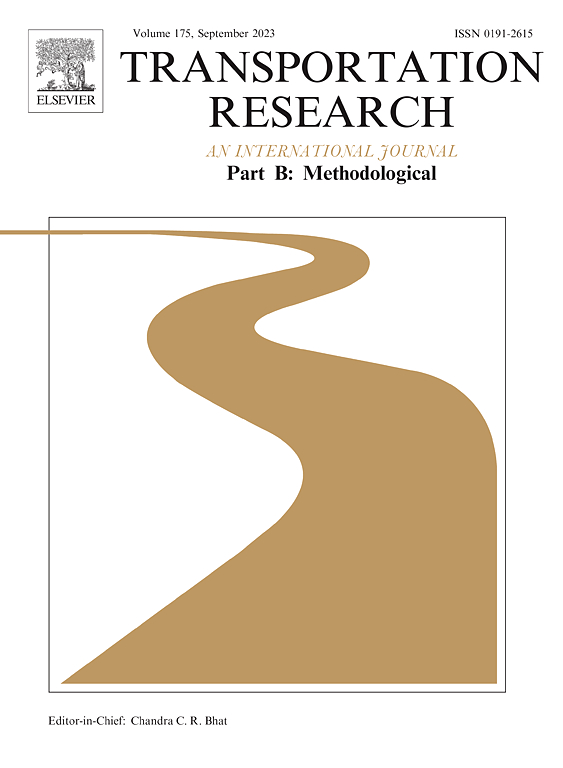自由职业司机的衰退选择:优化按需移动服务的调度菜单
IF 5.8
1区 工程技术
Q1 ECONOMICS
引用次数: 0
摘要
随着共享经济的繁荣,越来越多的兼职和自由供应商(即司机)加入按需移动服务。由于供应商的自主性和行为异质性,平台无法确保供应商一定会接受派单。缓解供应不确定性的一种方法是向供应商提供个性化的派遣建议菜单。因此,一个关键问题是确定哪些调度订单(可以是乘客或货物服务)应分配给每个供应商的分类菜单。本文对供应商的订单接受和选择行为(包括拒绝选项)进行了概率建模。我们提出了两个分类优化问题,即不相邻菜单和联合菜单,以最大化预期匹配数量。我们证明,不相邻菜单组合问题的目标函数是单调非递减亚模态的。相反,联合菜单组合问题的目标函数是非单调和非次模态的。因此,我们提出了一种标准贪婪(SG)算法来解决不连贯分类问题,并提出了γ∗-贪婪和局部搜索(LS)算法来解决联合分类问题。通过将订单捆绑到合并路线中,本文将提出的菜单分类方法扩展到送餐服务中。本文基于曼哈顿路网的实际需求进行了案例研究。研究结果表明,由于司机有拒绝派单的自主权,市场上出现了大量闲置司机和未匹配订单并存的情况。所提出的菜单分类方法可以抑制这种匹配摩擦。此外,数值结果表明,建议的算法在平台效率(如实现更多匹配)、客户体验(如减少等待时间)和司机收益(如减少司机之间的收入不平等)等方面都明显优于实际应用的传统调度策略(如一对一匹配)。本文章由计算机程序翻译,如有差异,请以英文原文为准。
Freelance drivers with a decline choice: Dispatch menus in on-demand mobility services for assortment optimization
With the prosperity of sharing economy, more part-time and freelance suppliers (i.e., drivers) join on-demand mobility services. Because of suppliers’ autonomy and behavioural heterogeneity, the platform cannot ensure that suppliers will accept a dispatch order. One approach to mitigate this supply uncertainty is to provide suppliers with personalized menus of dispatch recommendations. A key issue then is to determine which dispatch orders (that can be passenger or goods services) should be allocated into the assortment menu of each supplier. This paper probabilistically models the suppliers’ order acceptance and choice behaviour, including a decline option. We propose two assortment optimization problems, disjoint and joint menus, to maximize the expected number of matches. We show that the objective function of the disjoint menu assortment problem is monotone non-decreasing submodular. In contrast, the objective function of the joint menu assortment problem is non-monotone and non-submodular. Accordingly, we present a standard greedy (SG) algorithm to solve the disjoint assortment problem, and -greedy and local search (LS) algorithms for the joint assortment problem. By bundling orders into consolidated routes, this paper extends the proposed menu assortment methods to the context of meal delivery services. A case study is presented based on the real-world demand in the Manhattan road network. The results show that drivers’ autonomy to decline the dispatch orders creates substantial coexistence of idle drivers and unmatched orders in the market. The proposed menu assortment methods curb such matching friction. Moreover, the numerical results demonstrate that the proposed algorithms significantly outperform the traditional dispatching policies applied in practice, e.g., one-to-one matching, in terms of platform efficiency, e.g., achieving more matches, customers’ experiences, e.g., reducing waiting time, and benefits for drivers, e.g., tapering off the income inequality among drivers.
求助全文
通过发布文献求助,成功后即可免费获取论文全文。
去求助
来源期刊
CiteScore
12.40
自引率
8.80%
发文量
143
审稿时长
14.1 weeks
期刊介绍:
Transportation Research: Part B publishes papers on all methodological aspects of the subject, particularly those that require mathematical analysis. The general theme of the journal is the development and solution of problems that are adequately motivated to deal with important aspects of the design and/or analysis of transportation systems. Areas covered include: traffic flow; design and analysis of transportation networks; control and scheduling; optimization; queuing theory; logistics; supply chains; development and application of statistical, econometric and mathematical models to address transportation problems; cost models; pricing and/or investment; traveler or shipper behavior; cost-benefit methodologies.

 求助内容:
求助内容: 应助结果提醒方式:
应助结果提醒方式:


